General
Glistening in the sun
like a cluster of diamonds, with their dew-covered leaves
emanating the full spectrum of the rainbow, the name
"sundew" aptly describes the beauty of these carnivorous
plants that use a flypaper or adhesive trap to catch small
animal prey.
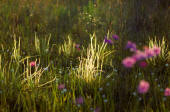 The genus name Drosera is derived from
a Greek word droseros for "dewy". Sundews typically
grow on the moist surface of bogs and marshy savannas,
often creating a large patch of shining red carpet. The genus name Drosera is derived from
a Greek word droseros for "dewy". Sundews typically
grow on the moist surface of bogs and marshy savannas,
often creating a large patch of shining red carpet.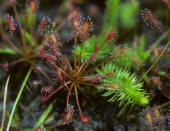 There are about 150
species of sundews worldwide over both the Southern and
Northern Hemispheres. By far, the heaviest concentration of
the species occurs in Australia -- particularly South
Australia and the southern part of Western Australia -- with
nearly 50 endemic species of sundews in this continent
alone. The southern part of Africa is also known for a large
number of sundew species. The shape and size of sundews
vary widely among different species. Seven species grow in the
continental United States.
 The north temperate forms of sundews
are generally perennial plants, with several leaves forming
a rosette. The plants have a short stem with fibrous roots.
The leaves of the sundew vary in shape and size in different
species, but the basic function and structural
characteristics are the same for all species. The leaves are
of two parts: a narrow petiole (leaf stem) at the leaf base,
and a leaf blade modified into an adhesive trap. The north temperate forms of sundews
are generally perennial plants, with several leaves forming
a rosette. The plants have a short stem with fibrous roots.
The leaves of the sundew vary in shape and size in different
species, but the basic function and structural
characteristics are the same for all species. The leaves are
of two parts: a narrow petiole (leaf stem) at the leaf base,
and a leaf blade modified into an adhesive trap.
Adhesive Trap
The characteristic dew-holding hairs on the sundew
leaf surface are called tentacles because they behave like one
during the prey entrapment. Each tentacle has a slender stalk tipped
with a round gland, which is enveloped with a
sticky mucilage produced by the gland itself. The gland is
also capable of producing digestive juices when prey is
captured.
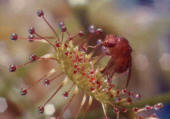 The tentacles play an important role in trapping
animal prey in sundews.
When an insect lands on a sundew leaf, it immediately
becomes mired in the sticky mucilage. As the insect struggles to escape, nearby tentacles also begin to bend toward
the insect. Although the movement of tentacles is rather
slow --- taking a minute to an hour
or more to bend
over the trapped prey --- there is no doubt that the bending of tentacles greatly improves the
sundew's chance of a successful catch. The tentacles play an important role in trapping
animal prey in sundews.
When an insect lands on a sundew leaf, it immediately
becomes mired in the sticky mucilage. As the insect struggles to escape, nearby tentacles also begin to bend toward
the insect. Although the movement of tentacles is rather
slow --- taking a minute to an hour
or more to bend
over the trapped prey --- there is no doubt that the bending of tentacles greatly improves the
sundew's chance of a successful catch.
In many sundew species, when a large prey is captured, the entire leaf also gradually folds around the prey. This
movement of leaves and tentacles brings more glands in
contact with the prey. Eventually, the glands on the tentacle tip begin to
secrete digestive juices. A small
insect is often seen completely enveloped
in the
blob of digestive fluids. As the insect body begins to dissolve,
the nutrients are promptly absorbed through the leaf and are carried away to the rest of the plant.
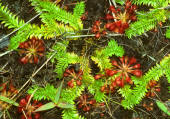 In a typical
natural habitat, many sundews grow together,
often covering a large area of marshy surface. This is
very much to their advantage, since insects
such as butterflies and dragonflies --- which are usually too large for
a single sundew to capture --- are seen successfully trapped
by the cooperation of many sundew plants each grabbing a part
of the insect body. In a typical
natural habitat, many sundews grow together,
often covering a large area of marshy surface. This is
very much to their advantage, since insects
such as butterflies and dragonflies --- which are usually too large for
a single sundew to capture --- are seen successfully trapped
by the cooperation of many sundew plants each grabbing a part
of the insect body.
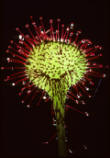 The upper surface of the leaf blade is
covered with numerous glands raised on a stalk. These
hair-like stalked glands, often referred to as "tentacles", hold a large droplet of sticky mucilage
at the tip. This is the basic trapping mechanism of the
adhesive trap. The secretions of viscous substances is
widespread in the plant kingdom, and many insects are known
to be attracted by glistening droplets. Unlike the case of
the pitcher plants where nectar are offered as a reward,
the adhesive trap provides no rewards. The upper surface of the leaf blade is
covered with numerous glands raised on a stalk. These
hair-like stalked glands, often referred to as "tentacles", hold a large droplet of sticky mucilage
at the tip. This is the basic trapping mechanism of the
adhesive trap. The secretions of viscous substances is
widespread in the plant kingdom, and many insects are known
to be attracted by glistening droplets. Unlike the case of
the pitcher plants where nectar are offered as a reward,
the adhesive trap provides no rewards.
When prey, usually a small insect,
lands on a sundew leaf, it becomes mired in the sticky
secretions. As the prey struggles to free itself, tentacles
begin to bend over the prey. In many sundew species, the
leaf itself also slowly folds around the prey, if the prey
is sufficiently large or strong to justify further securing. The mucilage appears to
contain no lethal substances and the trapped insects
typically die of suffocation as mucilage covers their
trachea during the struggle to escape.
Structure of Tentacle
A closer look at the sundew tentacles
reveals that, unlike a usual plant hair which is of
epidermal origin, the tentacle has a far more complex
structure exhibiting all the elements of the leaf itself. It
is composed of a tall, tapering stalk of multi-cellular
structure, topped with two layers of glandular cells.
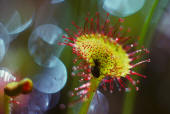 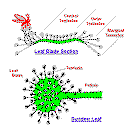 A
slender vascular strand can be seen in the stalk center to
support gland-to-leaf linkage.
Mucilage is secreted from the glands through their cuticular
discontinuity. In addition to these stalked glands
(tentacles), there are numerous sessile (stalkless) glands.
These are found on the leaf surface as well as on the stalks
of the stalked glands. Actual functionality of the tentacle,
however, appears far more complex and diverse than its
apparent structural manifestation. A
slender vascular strand can be seen in the stalk center to
support gland-to-leaf linkage.
Mucilage is secreted from the glands through their cuticular
discontinuity. In addition to these stalked glands
(tentacles), there are numerous sessile (stalkless) glands.
These are found on the leaf surface as well as on the stalks
of the stalked glands. Actual functionality of the tentacle,
however, appears far more complex and diverse than its
apparent structural manifestation.
The movement of the tentacle plays a
crucial role in the actual entrapment of prey and the
subsequent digestion-absorption sequence in sundews. The tentacles are
sensitive to physical stimulation, exhibiting the fast
tentacle movement. Upon stimulation of tentacles, the action
potential has been measured by researchers. The outer,
longer tentacles tend to respond more readily. The inner,
shorter tentacles require stronger stimuli. This initial,
fast movement is followed by a slower phase of movement,
often as a result of sustained physical simulation along
with certain chemical stimulation.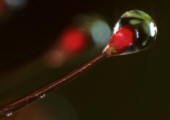
If the tip of the tentacle holding the
gland is cut off, the tentacle does not respond to the
direct stimulation, though the remaining stalk portion of
the tentacle does bend in response to the indirect stimuli
from nearby tentacles. This led to the traditional
hypothesis that the receptor of the tentacle is located in
the head. It is now noted that the cells structurally
homogeneous to the sensory cells of the
Venus flytrap's trigger hairs are the epidermal cells of
the upper part of the tentacle stalk where the stress of the
physical stimuli is most pronounced, replacing the previous
hypothesis. (Juniper et al, 1986).
Tentacle Movement
Detailed studies have been conducted
on the behavior of sundew tentacles by various authors,
including Charles Darwin and F. E. Lloyd. On the most widely
known species of sundew, Drosera rotundifolia, the
tentacles can be divided into three groups based on their
response characteristics to stimulation. Those tentacles
found on the periphery of the leaf blade -- usually the
longest tentacles of all -- are known as the "marginal
tentacles". Those near the leaf center are termed "central
tentacles" and are the shortest. Between the
marginal and the central tentacles grow tentacles of
intermediate height called "outer tentacles". By and large,
a similar observation holds for behavioral characteristics
in most sundew species, although some differences may be
noted due to the particular posture of tentacles in
different species with varying leaf shapes.
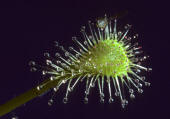
The marginal tentacle, when stimulated
directly, always bends toward the leaf center. This type of
bending motion toward a pre-determined direction, regardless
of the direction of outside stimuli, is known as the "nastic"
movement. The tentacle also responds to indirect stimulation
TO WHERE -- an impulse transmitted from outer or central tentacles.
When a direct stimulus is given to the marginal tentacles,
however, only the stimulated tentacle will bend, i.e., the
marginal tentacle does not transmit stimuli to other
tentacles. This behavior immediately distinguishes the
marginal tentacles from the other two groups of tentacles.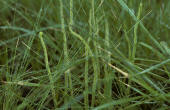
The central tentacle, on the other
hand, does not move when directly
simulated. This behavior contrasts to the other
two groups of tentacles. When stimulated, it does send out
impulses to the neighboring tentacles in a matter of
a few munites to a few hours.
For an indirect stimulation, the
central tentacle bends toward the point of the stimulus.
This behavior of the tentacle -- bending toward the
direction which has a consistent correlation to the source
of stimulation -- is known as the "tropistic" movement.
The outer tentacle, located in the
middle zone between the marginal and the central tentacles,
exhibits somewhat of a combined characteristic of these
neighboring tentacle groups. The outer tentacle responds to
the direct stimulation by exhibiting a rapid nastic motion,
just like marginal tentacles. It will transmit an impulse to
nearby tentacles as well.
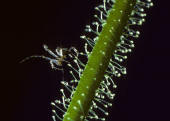 For indirect stimulation, the behavior
of both the marginal and the outer tentacles is more
complex, typically showing an initial nastic movement
followed then by a tropistic reaction, as if to correct
orbital errors, as it were, to reach the prey. The outer
tentacles are known to be more responsive and agile to the
indirect stimulus than the marginal tentacles. The actual
tentacle behavior may vary somewhat depending on where the
stimulus has originated, on different species, and on
growing conditions. For instance, the higher the
temperature, the more likely the tropistic reaction is to
dominate. For indirect stimulation, the behavior
of both the marginal and the outer tentacles is more
complex, typically showing an initial nastic movement
followed then by a tropistic reaction, as if to correct
orbital errors, as it were, to reach the prey. The outer
tentacles are known to be more responsive and agile to the
indirect stimulus than the marginal tentacles. The actual
tentacle behavior may vary somewhat depending on where the
stimulus has originated, on different species, and on
growing conditions. For instance, the higher the
temperature, the more likely the tropistic reaction is to
dominate.
Tentacle Bending Mechanism
The mechanism of tentacle bending is
not fully understood. The bending is precipitated by a
sudden drop of cellular pressure on one side of the tentacle
stalk. The resultant imbalance of pressure between the
opposite sides of the stalk causes the tentacle to bend. The
pressure differential first occurs near the tentacle base,
and then gradually moves upward toward
the tip.
Sometimes a quite rapid tentacle
movement can be observed in some species -- bending more
than 180 degrees in less than 60 seconds -- with a proper
stimulation (mechanical and/or chemical) under an optimal
condition.
Digestion and Absorption
Eventually the gland secretions are
switched from sticky substances to digestive juices.
Often a small
prey, having forced down to the surface of
a leaf by
flexing tentacles, is submerged in the digestive
fluids and suffocated. The bending motion of the
tentacles allows the prey to be transported to the
pre-designated center portion of the leaf blade where the
digestion takes place.
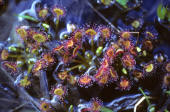 This brings about economies in
quantities of digestive enzymes. As the digestion
progresses, products of digestion are promptly absorbed into
the leaf interior through the leaf surface and, in a matter
of a few hours, begin to be carried away to the other parts
of the plant (Komiya et al, 1978). Numerous, tiny
sessile glands found on the entire surface and on the
tentacle stalks also aid in the rapid absorption of the
digested material. This brings about economies in
quantities of digestive enzymes. As the digestion
progresses, products of digestion are promptly absorbed into
the leaf interior through the leaf surface and, in a matter
of a few hours, begin to be carried away to the other parts
of the plant (Komiya et al, 1978). Numerous, tiny
sessile glands found on the entire surface and on the
tentacle stalks also aid in the rapid absorption of the
digested material.
Unbending of Tentacle
After the absorption is completed, the
tentacle returns to the original position. It is a reverse
process of bending, again due to pressure differentials.
This unbending is a slow process usually taking a day or
more. It is believed the unbending is a growth phenomenon
seen as the result of restoring the cellular pressure. As
such, the same tentacle is measured to be greater in length
by 10 percent or so after unbending. A given tentacle
is capable of
repeating the bending and unbending only a few times before
it reaches the growth maturity.
Inflorescence
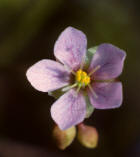 In the spring a slender flower stem appears in the rosette center. The flowers are generally small . The
flowering season lasts from spring through summer in the U.S.
Species. In the spring a slender flower stem appears in the rosette center. The flowers are generally small . The
flowering season lasts from spring through summer in the U.S.
Species.
For the most species in the temperate
zone, a tall scape appears from the rosette center in the
spring, which bears numerous flowers. Actinomorphic (radially
symmetric) flowers have five petals and are typically small
and plain. Most of the sundew flowers are believed to be
insect-pollinated. Usually a flower opens for one day. If
the pollination does not take place, the anther and stigma
are brought together as the flower closes at the end of the
day, thus effecting self-pollination. Many flower scapes are
produced and flowering continues through the summer season
for most species. |










 For indirect stimulation, the behavior
of both the marginal and the outer tentacles is more
complex, typically showing an initial nastic movement
followed then by a tropistic reaction, as if to correct
orbital errors, as it were, to reach the prey. The outer
tentacles are known to be more responsive and agile to the
indirect stimulus than the marginal tentacles. The actual
tentacle behavior may vary somewhat depending on where the
stimulus has originated, on different species, and on
growing conditions. For instance, the higher the
temperature, the more likely the tropistic reaction is to
dominate.
For indirect stimulation, the behavior
of both the marginal and the outer tentacles is more
complex, typically showing an initial nastic movement
followed then by a tropistic reaction, as if to correct
orbital errors, as it were, to reach the prey. The outer
tentacles are known to be more responsive and agile to the
indirect stimulus than the marginal tentacles. The actual
tentacle behavior may vary somewhat depending on where the
stimulus has originated, on different species, and on
growing conditions. For instance, the higher the
temperature, the more likely the tropistic reaction is to
dominate.
